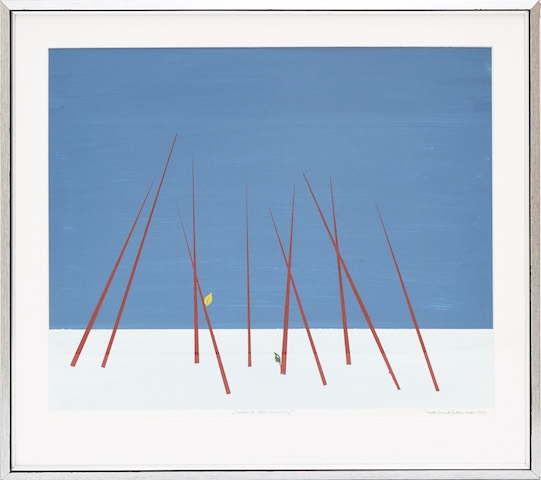On entering Let the River Flow, one encounters a lithographic print, 1852 (1981) by the Sámi artist Keviselie, aka Hans Ragnar Mathisen. An object resembling a pen nib cuts a line from top to bottom down the middle of a face. One half is blue and confident, the other red and screaming. The nib, which sits at the bottom of the page, pointing back up to the two halves, looks like a church spire, the numbers 18 and 52 on either side of its base: power, religion and language slicing through time and identity.
Let the River Flow is the culmination of three years’ research by OCA into contemporary art by the Sámi, an indigenous minority living across parts of Norway, Sweden, Finland and Russia (a territory called Sápmi). The show collects work by over 20 artists linked to the Áltá-Guovdageino Action, a 1978–82 protest against the damming of the Áltá river in northern Norway, where many Sámi live. The dam was built, but the protest and associated initiatives helped foster Sámi solidarity against ‘Norwegianisation’, a government policy forcing the assimilation of the non-Norwegian speaking Sámi and Kven populations that lasted to the 1980s. Keviselie’s 1852 sets the tone, recalling an uprising in that year wherein a group of Sámi killed a local liquor merchant and whipped the village priest. The leaders were executed, but the event resonates in Sámi and Norwegian history.
The exhibition’s layout spirals: numerous birchwood display modules are suspended on ropes from the ceiling of OCA’s converted riverside space, radiating in a fragmented circular motion. The materials and arrangement nod to duodji, usually understood as Sámi craft. Let the River Flow argues for a notion of duodji in which artmaking and art objects are inextricable from sociality and spirituality, part of everyday life. Iver Jåks’s Sámi Culture Against the Grain (1979) is a small toollike sculpture of wood and reindeer horn and skin. It twists as if Jåks let the woodgrain lead his carving, until its shaft abruptly hits a rough block at the base.
In 1978 Jåks was instrumental in forming the Sámi Artist Group, which foregrounded the integration of contemporary art with Sámi traditions, and many of the works in Let the River Flow are by the founding alumni. Aage Gaup’s vibrant wooden sculpture interprets the flows and stops of yoik, a Sámi vocal tradition; Britta Marakatt-Labba’s textiles picture encroaching threats to life and landscape; Trygve Lund Guttormsen’s vivid paintings and prints show parliamentary gatherings. The historical heart of the show, though, is a wall featuring an archive of newspaper clippings, photographs, publications, posters and other ephemera from the Áltá-Guovdageino Action. It shows the intimacy and smallness of the activist – and by extension, Sámi – community compared to the massive forces building the dam.
The Sámi Artist Group established a hub for activist meetings in the small village of Máze. Mai-Lis Eira and Elle Márjá Eira, from the younger Sámi artist collective Dáidadállu, update this legacy in two related videos: Mai-Lis’s 6 February 1981 (2018) mixes archival footage of the Sámi hunger strike that took place in protest outside the Norwegian Parliament in Oslo in 1979 with recent interviews of the participants, looking at the legacy of that moment now. Elle Márjá’s Don’t Fuck With Me (2018) is an aggressive pop music video reinterpretation of those events, but displaying an edge of disillusionment with the current results. Those events made a mark, but the problem remains. Though the Sámi now have a parliament, it is limited in power.
The spirit felt through the show is simple, not new, but exciting: top-down power is always potentially violent, separating us from creating and belonging. Let the River Flow provides a number of tactics to fight against that alienation: find comrades through a shared practice, never let your history be dismissed, take your legacy seriously.
Let the River Flow. The Sovereign Will and the Making of a New Worldliness at Office for Contemporary Art Norway (OCA), Oslo, 12 April – 3 June
From the Summer 2018 issue of ArtReview
